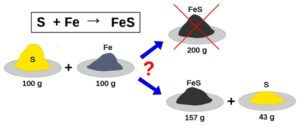The limiting reagent is defined as those reactant that is totally used up in the reaction medium. In most of the cases some of the reactants remain excess after completion of the reaction.
In this article ” limiting reactant example” the following examples of limiting reagent is discussed below.
- Formation of Ammonia
- Respiration Reaction
- Reaction between BaCl2 and AgNO3
- Oxidation of Magnesium
- Reaction between Sodium Peroxide with Water
- Reaction between C2H3Br3 with oxygen
- Oxidation of Cobalt oxide.
- Reaction between Silicon dioxide with H2F2
- Combustion of Benzene
- Combustion of Ethylene
- Oxidation of Ammonia
- Reaction between Fe2O3 with excess Carbon
- Combustion of Sucrose
Limiting Reactant Example

Image Credit: Wikimedia Commons
Formation of Ammonia
The balanced equation of the ammonia formation in Haber process reaction is shown below-
N2 + 3H2 = 2NH3
So the ratio of nitrogen with hydrogen is 1:3 in ammonia formation.
If 2 moles of nitrogen is reacted with 6 moles of hydrogen then ratio of 2 moles of nitrogen with 6 moles of hydrogen will be-
2 : 6 = 1 : 3
Thus (3-2)= 1 mole of nitrogen will be unreacted and 4 moles of ammonia will be produced as the product.
2 mol N2+ 6 mol H2 = 4 mol NH3
In the above example nitrogen is excess reagent and hydrogen is limiting reagent.
To know more please check : Peptide bond formation: How, Why ,Where ,Exhaustive Facts around it
Respiration Reaction
The balanced reaction of respiration is-
C6H12O6 +6O2 = 6CO2 + 6H2O + Energy
What amount of mass of CO2 forms in the above reaction if 30 gm Glucose is reacted with 50 gm of oxygen?
Mole numbers of glucose= 30 gm × (1 mol/ 180.06 gm mol-1)
=0.1667 mol glucose.
Mole numbers of oxygen= 50 gm× (1 mol/ 32 gm mol-1)
= 1.5625 mol oxygen.
[Molar mass of glucose and oxygen is 180.06gm. mo.-1 and 32 gm mol-1 respectively].
to use 1.5625 gm O2 , (1.5625/6) = 0.2604 mol glucose will be required. Or to use 0.1667 mol glucose, (0.1667*6) = 1.0002 mol oxygen will be needed because the ratio of the reactant side that is glucose with oxygen is 1:6.
the mole ratio of the reactant present in the reaction medium.
Oxygen: Glucose = 1.0002: 0.2604
= 3.84. Thus 0.2604 mole glucose will form (0.2604 * 6) = 1.0002 mole of Carbondioxide.
Left over or excess amount of oxygen is = (1.5625- 1.0002) mole = 0.5623 mole of oxygen.
So the limiting reagent of the above chemical reaction is Glucose.
Reaction between BaCl2 and AgNO3
25 ml 0.315 molar barium chloride (BaCl2) is reacted with excess silver nitrate (AgNO3) to form the precipitate of silver chloride (AgCl). 1.85 g AgCl will be isolated as precipitate. What will be the theoretical yield, and the percentage of yield of this reaction?
BaCl2 + 2AgNO3 = 2AgCl + Ba(NO3)2
Mole numbers of BaCl2 = Concentration of BaCl2 * total volume of the solution
= {(0.315 molar BaCl2)× (25/1000)} mole
=7.875× 10-3
Thus theoretical yield of AgCl will be-
(7.875× 10-3) mol BaCl2 × (2 mol AgCl/ 1mol BaCl2) × ( 143.3 g AgCl/ 1mol AgCl)
=2.257 g AgCl
Percentage of yield –
% yield = (actual yield/ theoretical yield) * 100%
= (1.85/2.25) × 100%
=82.22%
To know more please follow: 5+ Metallic Bond Examples: Explanation and detailed Facts
Oxidation of Magnesium
Calculate the mass of Magnesium oxide possible if 2.50 g Mg reacts with 16 g O2?
2Mg + O2 = 2MgO
(2.5g Mg / 24.3 g Mg)× ( 2 mol MgO/ 2 mol Mg)× (40.3 g MgO/ 1mol MgO)
= 4.15 g MgO
(16g O2/ 32 g O2)× (2 mol MgO/ 1 mol O2)× (40.3 g MgO/ 1 mol MgO)
=40.3 g MgO
In this example Mg is limiting reactant as it produces lesser amount of MgO than O2.
Reaction between Sodium Peroxide with Water
What is the limiting reagent if 80 g of Na2O2 is reacted with 30 g of H2O?
2Na2O2 + 2H2O= 4NaOH + O2
(80 g Na2O2/ 77.96g) = 1.026 moles of Na2O2
(30 g H2O/ 18 g) =1.67 moles of H2O
To consume all of the water 1.67 moles of Na2O2 are needed.
Thus Na2O2 is limiting reactant in this example.
Reaction between C2H3Br3 with oxygen
What is the limiting agent if 78 g of C2H3Br3 will be required to react with 50 g O2?
4 C2H3Br3 + 11 O2= 8CO2+ 6H2O + 6Br2
78g C2H3Br3= 0.292 moles of C2H3Br3
0.292 moles of C2H3Br3 × (8 mol CO2/4 mol C2H3Br3) × ( 44.01 g CO2/ 1 mol CO2) = 25.70 g CO2
50 g O2= 1.5625 moles of O2
=50.01 g CO2
Thus C2H3Br3 is limiting reactant in this example.
To know more please follow: Peptide Bond vs Ester Bond: Comparative Analysis And Facts
Oxidation of Cobalt oxide
What is the limiting reagent when 30 g of CoO is combined with 2.8g of oxygen?
4CoO+ O2 = 2Co2O3
(30g CoO/74.9g) = 0.400. moles of CoO
2.8 g of O2 =0.0875 moles of O2
To use all the oxygen (0.0875× 4)= 0.35 moles of cobalt oxide is required. But there are 0.400 moles of CoO.
CoO is excess reagent and oxygen is limiting reagent.
Reaction between Silicon dioxide with H2F2
Identify the limiting reagent when 30 g of SiO2 reacts with 22 g of H2F2?
SiO2+ 2H2F2 =SiF4 +2 H2O
(30g of SiO2/ 60.08g) = 0.4993 moles of SiO2
22g of H2F2= 0.6875 mol of H2F2.
To consume all the silicon dioxide (0.4993× 2)= 0.9986 mol of H2F2 will be required. But there is only 0.6875 moles of oxygen present.
Thus H2F2 is the limiting reactant in this example.
Combustion of Benzene
The balanced equation is-
C6H6 (l)+ 15 O2 (g) = 12CO2 (g) + 6H2O(g)
What is the limiting reagent if 1.2 mol of benzene is reacted with 12 mol of oxygen?
1.2 mol benzene× (15 mol oxygen/ 2 mol benzene)
=9 mol of benzene
If 18 mol of oxygen are present then (18-9) = 9 mol of oxygen remains unreacted.
Thus benzene is limiting reagent.
To know more please follow: Function of peptide bond: detailed fact and comparative analysis
Combustion of Ethylene
What is the limiting reactant if 5 g of ethylene (C2H4) is combusted with 3.2 g of oxygen?
C2H4(g) + 3O2(g)= 2 CO2 (g) +2 H2O(g)
(5g ethylene/28g) = 0.178 moles of ethylene
3.2 g of oxygen = 0.1 mole of oxygen
To use all the ethylene (0.178× 3) = 0.534 moles of oxygen will be required. But there is only 0.1 mole of oxygen is present.
Thus oxygen is limiting agent in this example.
Oxidation of Ammonia
What will be the limiting agent when 5.5 g of ammonia is reacted with 16 g of oxygen?
4NH3 (g) +5 O2 (g) = 4NO(g) + 6H2O(g)
(5.5 g of ammonia/17g) = 0.323 moles of ammonia
(16 g of oxygen) = 0.5 moles of oxygen
No of moles of NO =0.323 mol NH3× (4 mol NO/ 4 mol NH3)
=0.323 mol NO
Number of moles of NO from O2 calculation= 0.5× (4 mol NO/ 5 mol NO) = 0.4 mol NO
Here ammonia acts as limiting reactant.
Reaction between Fe2O3 with excess Carbon
What is the limiting agent if 0.26 mol of Fe2O3 is combined with 14 g of carbon?
Fe2O3 + 3C = 2Fe +3CO
(0.26 mole of Fe2O3/159.69g) = 1.62× 10-3 moles of Fe2O3
(14 g of carbon/12 g) = 1.167 moles of carbon
To use all the Fe2O3, (1.62× 10-3× 3)=4.86 × 10 -3 moles of carbon will be required, but carbon is present in excess amount.
Thus Fe2O3 is limiting reactant in this example.
Combustion of Sucrose
10 g sucrose is reacting with 8 g of oxygen. Which one is the limiting reactant?
C12H22O11 + 12O2 = 12CO2 + 11H2O
(10 g sucrose/342.3 g) = 0.0292 moles of sucrose
(8 g of oxygen/ 32g) = 0.25 moles of oxygen
To use all the sucrose (0.0292× 12) = 0.350 moles of oxygen will be required, but oxygen is present in the lesser amount than the required amount.
Thus Oxygen is the limiting reactant in this example.
Also Read:
- Example of relative motion
- Destructive interference of wave example
- Motion parallax example
- Frequency of a wave example
- Dynamic equilibrium example
- Negative frequency example
- Neutral equilibrium example
- Transverse wave example
- Negative velocity example
- Example of density change

Hello,
I am Aditi Ray, a chemistry SME on this platform. I have completed graduation in Chemistry from the University of Calcutta and post graduation from Techno India University with a specialization in Inorganic Chemistry. I am very happy to be a part of the Lambdageeks family and I would like to explain the subject in a simplistic way.
Let’s connect through LinkedIn-https://www.linkedin.com/in/aditi-ray-a7a946202